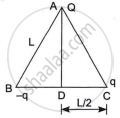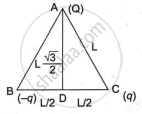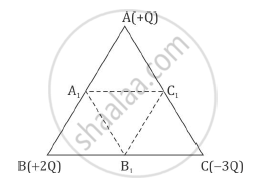Advertisements
Advertisements
Question
Three-point charges Q, q and -q are kept at the vertices of an equilateral triangle of side L as shown in the figure. What is

- the electrostatic potential energy of the arrangement? and
- the potential at point D?
Solution
- The electrostatic potential energy of the arrangement.
U = `1/(4piepsi_0)[((Q) xx (-q))/L + ((-q)(q))/L + ((q)(Q))/L]`
= `1/(4piepsi_0.L)[-qQ - q^2 + qQ]`
U = `-q^2/(4piepsi_0.L)` 
The potential at point D.
`V_D = 1/(4piepsi_0)[((-q))/(L"/"2) + q/((L"/"2)) + Q/(Lsqrt3"/"2)]`
`V_D = 1/(4piepsi_0) . (2Q)/(sqrt(3)L)`
⇒ `V_D = Q/(2sqrt3piepsi_0L)`
APPEARS IN
RELATED QUESTIONS
Three point charges, + Q + 2Q and – 3Q are placed at the vertices of an equilateral triangle ABC of side l. If these charges are displaced to the mid-point A1, B1 and C1, respectively, find the amount of the work done in shifting the charges to the new locations.

A small test charge is released at rest at a point in an electrostatic field configuration. Will it travel along the field line passing through that point?
What is the work done by the field of a nucleus in a complete circular orbit of the electron? What if the orbit is elliptical?
We know that electric field is discontinuous across the surface of a charged conductor. Is electric potential also discontinuous there?
Guess a possible reason why water has a much greater dielectric constant (= 80) than say, mica (= 6).
Three point charges +q each are kept at the vertices of an equilateral triangle of side 'l'. Determine the magnitude and sign of the charge to be kept at its centroid so that the charges at the vertices remain in equilibrium.
Potential energy of two equal negative point charges 2µc each held lm apart in air is:-
When one electron is taken towards the other electron, then the electric potential energy of the system ______
A point charge q0 is moving along a circular path of radius a, with a point charge Q at the centre of the circle. The kinetic energy of q0 is ______.
